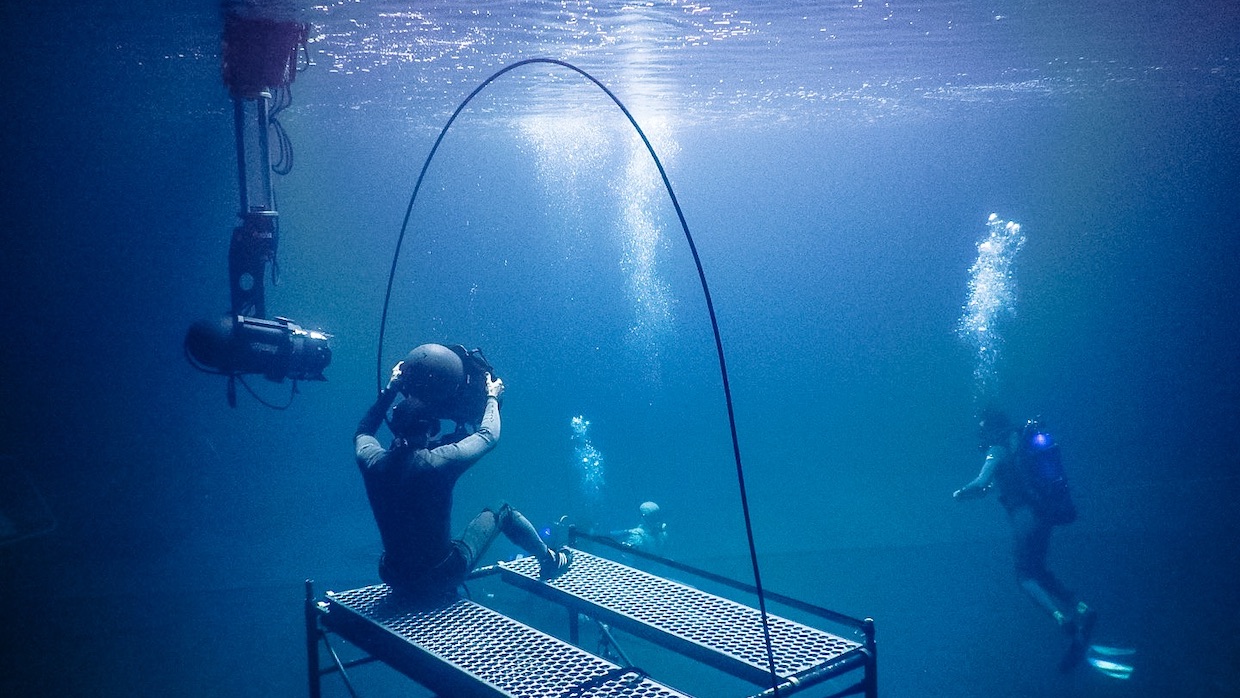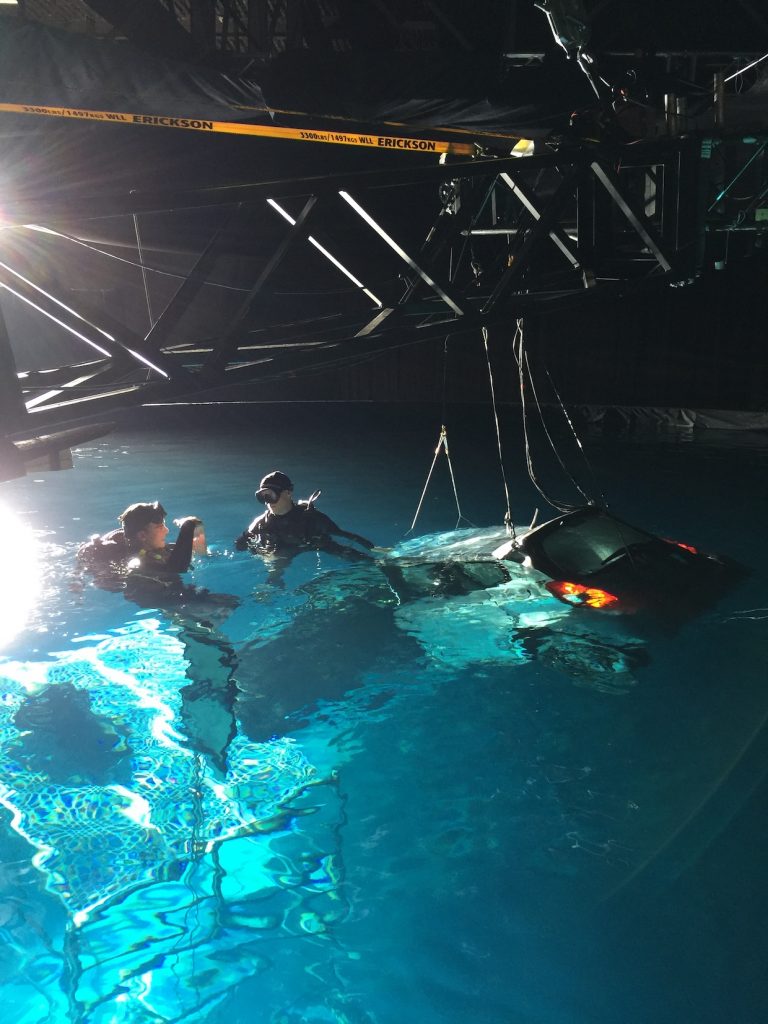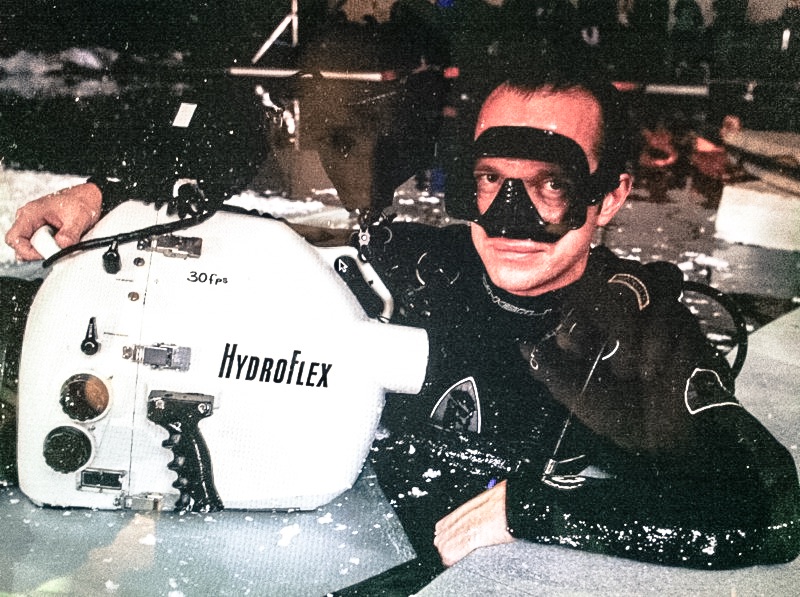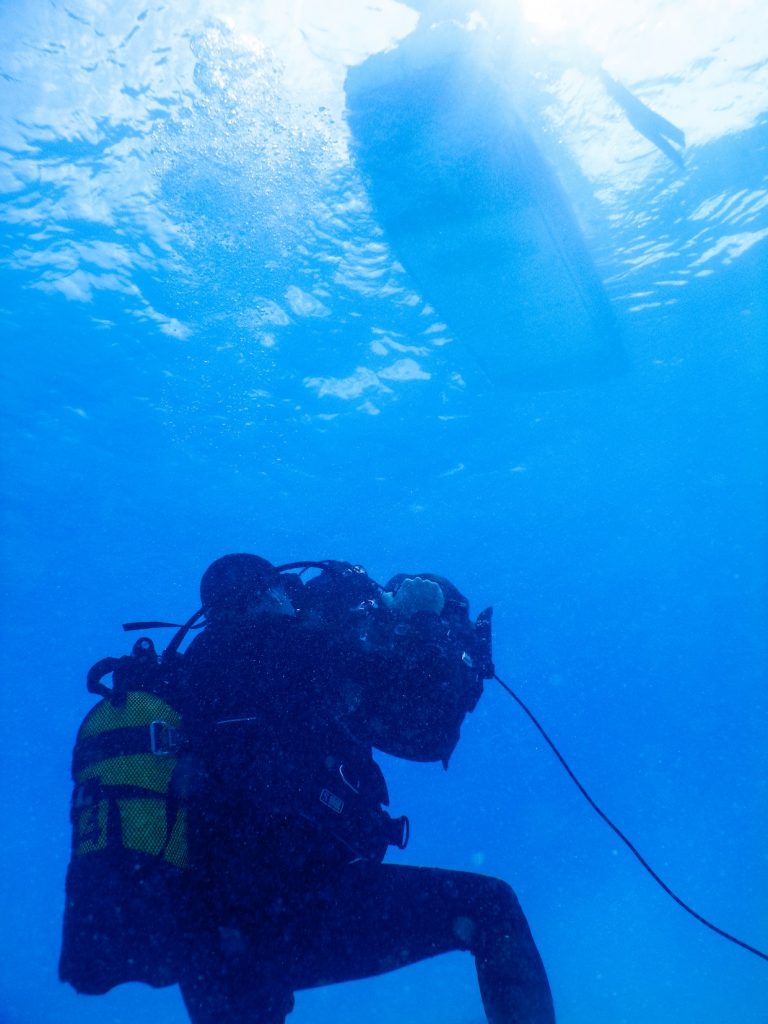 Back to selection
Back to selection
Shutter Angles
Conversations with DPs, directors and below-the-line crew by Matt Mulcahey
“It Pays to Already Be a Good Diver”: Ian Seabrook on His Career as an Underwater Cameraman
 Ian Seabrook shooting underwater
Ian Seabrook shooting underwater Ian Seabrook is an aquatic Zelig for film franchises. He crossed paths with Deadpool, RoboCop, Godzilla and the Blair Witch. He joined the Pirates of the Caribbean, X-Men and Mission: Impossible. He sat ringside for Freddy vs. Jason, Aliens vs. Predator and Batman v Superman.
So it’s understandable if he can’t quite recall which Hellraiser sequel served as his baptism as an underwater cameraman. “I think it was four or five, I don’t even know what number they’re up to at this point,” said Seabrook.

What he does remember about that job is an enduring lesson of underwater photography—you may only get a few chances at a shot, whether it’s an anxious thespian or a frolicking dolphin, so you better be ready.
“On that movie I had to shoot what’s a pretty common underwater sequence where a couple is trapped in a car that’s gone off a bridge,” said Seabrook. “The actress was not comfortable in the water at all. So, we built a platform in shallower water with just a fake seat and a car door, and I shot it with a tighter lens and added a bunch of bubbles. It taught me to how to figure things out quickly.”
With three movies out this summer in Army of the Dead, Old and Jungle Cruise, the amphibious Seabrook—who also works as a terrestrial 2nd unit DP—talked to Filmmaker about his unique vocation.
Filmmaker: I don’t know which component typically comes first for underwater cinematographers—the diving or the filmmaking—but for you, it was the former.
Seabrook: Correct. I lived in Australia for a couple years and got my diver certification on the Great Barrier Reef. I’d always been interested in diving through National Geographic, staring at the photos of all the faraway lands in the magazine, and then from watching the National Geographic specials on Sunday nights when I was younger. I was also quite intrigued about scuba diving after seeing [the 1965 James Bond film] Thunderball. I already had an interest in stills photography and had done a lot of developing in the darkroom and I was always interested in taking the camera underwater, but I didn’t know anyone who did it and there weren’t really any books on the subject I could find. You had to just kind of get the camera and get in. So I bought a Nikonos, which is a Nikon underwater camera with slide film, and just started shooting. It was a lot of trial and error at first.
Filmmaker: So eventually you left Australia for Los Angeles and got into camera department work?
Seabrook: Yeah, I started at the bottom as an unpaid intern. I think the first thing I worked on was the American remake of La Femme Nikita, Point of No Return (1993). I was living in L.A. and working on low budget stuff, like a lot of people do when they first get there. I started bugging people who were doing underwater cinematography for work, but it’s very specialized so the competition for those jobs was pretty fierce. I started working as a surface housing assistant, then transitioned into underwater focus pulling because I was already focus pulling on land at that point. Then in 1998 I started shooting [underwater]. The first thing I ever shot was a Bud Light commercial.
Filmmaker: When you were starting out as an underwater AC, was there wireless or were you in the water pulling off of the housing?
Seabrook: When I was pulling focus, I usually would use a whip attached to the focus knob on the housing so I wasn’t tugging or pulling on the housing and interfering with the operator, who most of the time was Pete Romano from HydroFlex. That was before the first remote focus. I think the first one was the Preston Marine Fiz, which was hard-wired into the housing. Now it’s usually an AC on the surface pulling focus, but back when I was pulling underwater, there were some things you could do [to make the job easier]. If you were in a tank, you could put sandbag marks down or dive weights. But if you’re in the open ocean and there’s 200 feet of water below you, you’re not going to have any frame of reference. If you’re not a focus puller on land, you’re going to have a real tough time doing it underwater.

Filmmaker: What are the options like for underwater lighting units? Are they moving more and more toward LEDs like surface units seem to be?
Seabrook: We used to always use the HydroFlex 1.2K HydroPars or the HydroFlos, which are their underwater fluorescent tubes. That was industry standard for many, many years. I still use them, but LED lighting has taken over somewhat. We’ll still use either tungsten or HMI units for our surface glow and sometimes when we need more punch I’ll still use an underwater 10K from HydroFlex, which we did on Batman v Superman because of the stop we were shooting at. But underwater—especially with blue or greenscreens—the LED lights are pretty remarkable. I use a lot of Astera tubes now, but you have to preprogram everything. You can use your phone to change the color temperature or intensity, but you have to do it on the surface. Sometimes we might take the lights underwater at 50 percent [intensity] and 5000 kelvin, then you go under and realize they’re too hot or not hot enough. Well, it’d be so much easier to be able to physically do it on the tube instead of having to mark where the lights were, take them back to the surface, use the phone to change the (settings), then go back down. I’ve been working with a company to develop tubes that you can make adjustments on underwater. Having underwater adjustability for anything is just so much easier.
Filmmaker: What is your crew like normally? Do you have an underwater G&E team?
Seabrook: Typically it’s good to have an underwater electric or gaffer, but because it’s so specialized fewer people do it and do it well. Having someone who’s actually both a good grip and a good diver is kind of a rarity. That’s why I try to use the same guys if they’re available. As far as underwater grips are concerned, the key grip would be responsible for ordering the package that we’re going to work with. That would include all the stands, all the flyswatters and lifts if we need to block out the sun or for overhead rigging. It’s not a huge package, but there’s a standard underwater package that we have with Ultrabounce and Grid Cloth and frames, though sometimes I’ll just lay [that bounce] on the bottom of the tank or the lake or whatever we’re shooting in just for some small bit of bounce, and weigh it down with crane weights. We set flags, we set diffusion, we set bounces. We do all those things that you normally do on land, it’s just typically to a lesser extent.
Filmmaker: Three films you worked on have been released this summer: Army of the Dead, Old and Jungle Cruise. On Army of the Dead you shot 2nd unit— no underwater work?
Seabrook: Yeah. I really like working with (director) Zack Snyder. He’s very trusting and enthusiastic. He’s just got a lot of great energy and creates a very good environment to work in. Damon Caro, who is Zack’s stunt coordinator, was the 2nd unit director. We did all the aerial work, we did quite a few fight scenes. There’s a kitchen fight scene where Chambers has to fight her way out of all these zombies and we shot all of that. That was a challenge because that whole sequence is essentially lit by glow sticks and flashlights. It was all basically Quasar tubes set to match the color of the glow sticks and the odd SkyPanel here and there. We also had to make sure when Chambers [played by Samantha Win] drops her weapon, she had it aimed toward the kitchen so [the flashlight on top of the gun] would backlight her.
Filmmaker: Snyder was also main unit cinematographer and he used these rehoused 1960s Canon Rangefinder lenses that are like a T1. How were those lenses to work with?
Seabrook: Yeah, the Canon Dream lenses. They were rehoused by a company called Zerø Optik in Los Angeles, because the lenses were not able to work with Preston Cinema Systems or any kind of remote focus. For the focus pullers it would’ve been a nightmare. So, they had to have housings placed over them with the proper focus marks engraved so that the whole thing was calibrated properly.
Main unit only had ten lenses and they ran two cameras the whole time, so we would borrow one or two lenses if we could or we would use, I think, Sigma lenses. They were the closest lenses stop-wise that we could use [with the Red’s Monstro 8K VV sensor]. It was very difficult for the focus pullers. Zack’s idea was to basically break the iris and shoot everything wide open, which was .95. These days it’s all “no marks and just pull off the monitor,” but when there’s really no depth of field to focus on, it’s tough.
Filmmaker: I know some of M. Night Shyamalan’s Old was shot in the Dominican Republic. Was the underwater portion shot there as well?
Seabrook: Old was entirely shot there. I was called in toward the end of filming. I had worked with Night prior on Glass and worked with his [cinematographer] Mike Gioulakis three or four times. We shot the underwater work at the Pinewood tank in the Dominican Republic. It was a set that was basically built into the tank when it was dry, then they filled the tank with water afterward. That’s normally the procedure for building any kind of set. You either lower it into water or have it placed in a tank in a facility, then fill water around it. The Old set was basically 60 feet of tunnels that the actors had to swim through. It was built by Naaman Marshall, who’s a very good production designer. Most of the film was shot on 35mm, but we did a lot of the underwater work digitally because Night didn’t really want to wait for the 10-minute camera [magazine] reloads with the amount of time the cast was going to be in the water.
Filmmaker: When you’re working with an underwater set, do you typically have a chance to do a walk-through before it’s submerged to preplan angles and shots?
Seabrook: Yes and that was for sure the case with Jungle Cruise. I was flown in and had a meeting with the director, Jaume [Collet-Serra], with all the production personnel and then from there I had several meetings with the art department looking at the sets that were still being constructed. So, I got all the blueprints and plans, and also got to talk to the art department about what materials to use and not to use. You want to make sure that the materials are not going to dissolve quickly in water. On Batman v Superman, both myself and Amy Adams got ear infections from the set rusting because the materials weren’t sealed. You’re supposed to learn from experience, so I was pretty adamant with the Jungle Cruise art department about materials and they appreciated the input.

Filmmaker: In Jungle Cruise, you have shafts of light in the underwater action scene where Emily Blunt’s character is trying to solve an oversized puzzle. On land, you have to shoot through haze or atmosphere usually to get those shafts to register. How do you get them underwater?
Seabrook: Actually, if you’re underwater in the open ocean and the water visibility is clear, you’re going to get those God Beams or light shafts from the sun. In order to replicate that (in the tank), it’s usually an 18K or an Arrimax or something like that.
Filmmaker: There’s a cyan tint to the Jungle Cruise underwater scenes. People tend to have strong opinions about how blue moonlight should be. Is it similar with underwater scenes? Do people have different thoughts on how blue the water should be?
Seabrook: If you don’t have any lights and are shooting it just au naturel, everything does end up looking blue and the skintones look really, really flat. You have to add some light source, even if it’s just a bounce for the sun. For Jungle Cruise, we were bashing through M90 surface lights. Then I augmented by bouncing a lot of light inside the puzzle piece where Emily Blunt’s character was and sometimes using Astera fixtures just barely off camera turned down low to give the actors a little bit of something. Sometimes, if Emily’s character and the camera both moved just right, we’d get these little specular highlights that gave her a really lovely backlight.
Filmmaker: I don’t know how much of that scene is actually Dwayne Johnson and Emily Blunt in the water, but you’re able to create the illusion that it’s them.
Seabrook: Emily’s stunt double Lauren Shaw is a jack-of-all-trades stunt person who can do it all. Her breath-hold was staggeringly good and she was a good body match for Emily. I’ve certainly had it where the doubles don’t match or they have to wear a wig and the wig doesn’t react properly underwater, so we were lucky to get a match that good.
Filmmaker: Anything else you want to add before we wrap up?
Seabrook: For anyone looking to get into this, it pays to already be a good diver. It’s a lot more difficult than just holding the camera and aiming it underwater. Often times you are a one-man band and [the diving has to be second nature] because you can’t be concentrating on that. I remember I was doing a job with cinematographer Don Burgess, who shot Forrest Gump, and one of the crew saw me working and said, “Oh, that looks like so much fun.” He turned to them and said, “Actually, it is really difficult. You have to compose. You have to light. You have to grip. You have to work with special effects. You have to do the work of 11 people and make sure the cast doesn’t drown.” And I just thought, “Wow, thanks Don,” because he said it all.
Matt Mulcahey works as a DIT in the Midwest. He also writes about film on his blog Deep Fried Movies.
